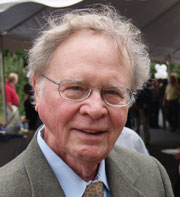|
PROFILES: News about people from AGI and its 44 member societies
Archive of past Society Page/Profiles stories by date
Wallace Broecker: Changes in the atmosphere
 |
Wally Broecker's work on the oceans' impact on climate has helped change the way scientists think about carbon dioxide and climate change. Photograph is by Ken Kostel. |
Wally Broecker’s pioneering research into the oceans’ role in climate change, including his idea in 1987 of a worldwide “conveyor belt” system of ocean currents that transports heat around the planet and affects climate, has not only propelled forward new research on the oceans and climate, but has also turned up in pop culture. The ocean conveyor, for example, plays a key role in both former Vice President Al Gore’s documentary An Inconvenient Truth and the scientifically flawed but earnest climate change movie The Day After Tomorrow.
Broecker has spent most of his five-decade-long career at Columbia University as both student and professor, studying glacial/interglacial climate change and using geochemical tracers to study carbon dioxide in the oceans and atmosphere. As an expert on issues of climate change, he has lent his voice to television, radio and other panels and received numerous awards for his work.
Most recently, Broecker received the 2006 Crafoord Prize from the Royal Swedish Academy of Sciences for his work linking ocean chemistry to carbon dioxide in the atmosphere. He talked with Geotimes reporter Carolyn Gramling about his experiences advising politicians about the consequences of climate change and his hopes for new technologies of carbon sequestration.
Q: You’ve been asked to advise the government on climate change at various times — how did that come about?
A: When [Jimmy] Carter was in office, I was asked a couple of times to go before several Senate and House committees to discuss carbon. I remember meeting with some great senators at the time. Five or six of them were giants of the Senate and they really got interested in this, until Reagan came in.
Q: Have you helped advise any more recent administrations?
A: It’s not that I’ve been saying no, but I haven’t been asked. It may be that with the new Congress there will be some changes.
Q: How early in your career did find yourself involved in public discussions of climate change?
A: Over the first 23 years of my career, from 1952 to 1975, there was no warming, and I puzzled over that. In 1975 I published a paper in Science to try to explain why: Combining the temperature cycles from the [1966] Century ice core in Greenland with carbon dioxide, [it seemed that] the natural cycle may have been cooling the planet about as much as carbon dioxide had been warming it. And if that’s the case, then we’re in for a pronounced warming. I was right — the climate did start to warm in 1976, and has been ever since.
Then in 1980, new ice core results showed that carbon dioxide was lower in glacial times. That was an “aha!” — cold period, lower carbon dioxide. That focused me more on carbon dioxide changes. In the mid-1980s, I proposed this conveyor idea — the interaction between the ocean and atmosphere. That was also right, but the thing that I missed at the time was the importance of sea ice and how it allowed impacts to be spread over much wider areas than would have been dreamed of in the 1980s.
Q: Were you at all involved in the Intergovernmental Panel on Climate Change, which released its Fourth Assessment Report in February?
A: No, but I think it’s a wonderful thing. Richard Alley (of Pennsylvania State University, a co-chair on the report) is a very good friend of mine, and he’s good at all that stuff. I prefer to just do my science and have an impact in a less direct way.
Q: What sort of projects are you interested in these days?
A: There’s a lot of research to be done on where to put the carbon dioxide. Klaus Lackner [also at Columbia University] has become my main hero. He was talking at a Canada 2020 meeting about something I thought was crazy, capturing carbon dioxide and mineralizing it. As time went on, I realized that was possible, but would be a big question of cost. ...
I’ve also been pushing alternate energies, such as coal gasification plants that take out carbon dioxide. If we’re going to stop the carbon dioxide from building beyond double [current levels], we’ve really got to move fast. I have a new article in [the March 9] Science in which I talk about a “carbon pie,” the absolute limit of the carbon we’re going to add to the atmosphere, which will have to be divided among the nations of the world in one way or another. It’s in the interest of countries to make an agreement [about divvying it up] while the pie is still big.
Q: Are you also working on new research?
A: I’m a paleoclimate person, really. I’m interested in how the ocean circulated during glacial times. And I’m interested in revisiting the world’s closed-basin lakes, which lose water only by evaporation. Theorists say in a warmer world it should get wetter in the tropics, and drier in the extra-tropics. I want to make a big point of the water — water is the big issue for what global warming’s going to do.

 Subscribe
Subscribe


